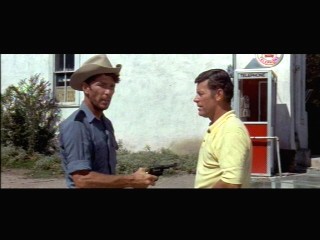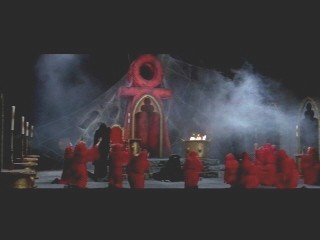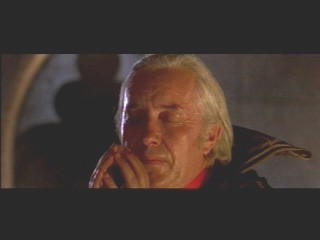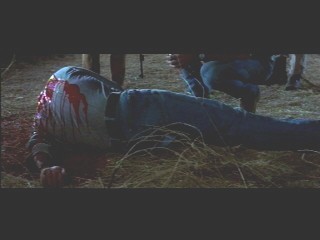
|
|
|
|
|
|
|
|
|
|
|
|
|
(1970) Director: Bernard McEveety
Though the name L. Q. Jones may not ring a bell even with those who have more than a passing interest in cult movies, it's almost certain that you have come across some of his movies over the years. If you look at his resume, you can see a number of impressive credits he has built up during the decades. As I mentioned in my review of Route 666, he appeared in a number of Sam Peckinpah movies. But his acting accomplishments go far beyond Peckinpah. Since starting his acting career in the '50s, he has managed to secure roles in a number of prominent movies. The '50s saw him in movies like The Naked And The Dead, the '60s saw him in movies like Hell Is For Heroes and Nevada Smith. In the '70s and '80s he was in a number of cult movies like White Line Fever, Lone Wolf McQuade, and Timerider. Since then he's appeared in movies like Casino and The Mask Of Zorro. You still might not be able to picture him, but if you were to see a picture of him, you'd almost certainly have a feeling that you recognize him from some moviegoing experience in your past - just like with that long-haired and balding Asian guy with a Fu Manchu-style mustache you have constantly seen over the years playing the role of "evil henchman" in action movies. (His name is Al Leong, if you're curious.) Though you might know about Jones and his acting career,
there's a good chance that you don't know that he has been involved in Though Jones gave the directing duties to someone else this time, he still had much control over the movie, not just as one of the actors, but as the movie's producer and screenwriter. The story here will no doubt have an air of familiarity to most viewers, even those who aren't horror aficionados. Dallas' Charles Bateman plays Ben, a widower raising his sweet little girl K.T. (Geri Reischl, who also played the "fake" Jan Brady in The Brady Bunch Hour.) On K.T.'s birthday, Ben decides to drive her to her grandmother, taking along his girlfriend Nicky (Ahna Capri, Enter The Dragon) on the trip. Despite driving on a major highway, they get lost (?), and they turn off the highway when they see a sign pointing the way to the small town of Woodley. Little things along the way suggest something is not quite right - things like losing radio reception, or passing a car that had been flattened like a pancake while the occupants were still in it. The utterly bizarre reception they subsequently get from the sheriff (Jones) and the townspeople finally gives them a clue, and they try to hightail it out of the area. But just like in almost every movie where people try to escape early on from a weird town, a mysterious figure suddenly pops up in the middle of the road (inevitably making a sudden disappearance afterwards), causing Ben to swerve, wreck the car, etc. So they find themselves stuck in Woodley, and have yet to learn what evil is going on... unlike us, because a title like The Brotherhood Of Satan isn't exactly a subtle one. This isn't exactly an original premise. Though if I may
be allowed to play, ahem, devil's advocate for a short period of time,
I would like to point out that although This is a rare drive-in movie that wants to induce chills in its audience more by the power of suggestion. Some of the ways it does this show some real though went into their planning. One such moment happens in the first few minutes, as the three protagonists are driving down the highway. Typically in cases like this, you get a good amount of inane banter and plot exposition spoken by the protagonists. But this time around, the protagonists utter not one word. All we hear during these several minutes is the hum of the engine and music from the radio. Then things start to slowly change, hinting something is not right - the rain outside suddenly stops, everything turns bright from the re-emerging sun, and then the music on the radio turns into static. We see and share the confusion and unease on the protagonists' faces. It's creepy, because the scene comes off in the most realistic way possible, right down to the fact that no music is inserted in to try and underline the eeriness. (In fact, there's only a limited amount of music in the rest of the movie.) You'd never think this mood came from someone whose previous work was mostly directing episodes of TV westerns. More so when you see how well McEveety uses the movie's 2.35:1 aspect ratio; even in cramped indoor locations, everything and everyone in range fits together incredibly well, a number of times showing us two or more things happening at the same time. So keeping in mind all of this material I just
mentioned, you really can't call The Brotherhood Of Satan
one of the worst examples of this particular situation. Unlike some
other movies that have followed this formula, this As it turns out, all this effort we make on these characters really doesn't matter. These three are really boring individuals, little more than a device for the movie to rotate around. K.T. disappears halfway through and only reappears near the end. Nicky's one contribution is to stop the movie cold for several minutes in order to have a dream sequence that's utterly pointless and incoherent, even though a significant portion of it consists of footage we've already seen. Though Ben does do some things, it's only as a member of a group of town residents, nothing individual or major; he isn't really needed at all. You get a sense from Bateman himself that he sees the futility of putting in any work, which goes a long way to explain his utterly colorless performance. The acting from the other players isn't that much better, with the exception of Strother Martin (Cool Hand Luke). It's clear that he's having a lot of fun playing the leader of the secret Satanic cult, hamming up his various proclamations and body movements to borderline camp, though carefully restraining himself until the wild climax allows him to fully let loose. Even when his character is in a much calmer mood, his performance is compelling enough that it almost makes you overlook some unanswered questions about his character and the cult. Why did he choose this town? Couldn't he find a less conspicuous way to get what the cult needs? Who are those figures in black? Why aren't the townspeople noticing the arrival of the cult members, seeing how individually they don't seem to be (if at all) powerful? Such utter lack of explanation is not just limited to
Martin and his cult. Take the time when the three protagonists are
reunited with the sheriff and some of the townspeople,
Check for availability on Amazon (VHS) See also: The Devil's Rain, The House On Skull Mountain, Nightmare At Noon |
 movie production not just as an
actor. You probably have heard of the science fiction movie A
Boy And His Dog. Jones didn't just appear (briefly) in the
movie; he also directed, produced, and wrote the screenplay that
adapted the original Harlan Ellison short story. It was a big success,
though strangely Jones subsequently didn't seem very interested in
doing any more behind the camera, save from directing some episodes of
The Incredible Hulk. Perhaps he felt he couldn't top himself after
making that cult classic. Perhaps the movie took such great effort to
make that he didn't feel the potential reward was worth it. Maybe this
feeling came up with simultaneously looking back on his previous works
behind the camera, which weren't very successful. Have you heard of The
Devil's Bedroom, which he directed, produced, and starred in?
Or The Witchmaker, which he produced and made an
appearance in? It's possible some of you might at least heard
of The Brotherhood Of Satan - unlike the other movies
he produced, this one upon completion was picked up by a major
Hollywood distributor, and has been kept more or less available to
audiences over the years, including a recent DVD release. It still
doesn't seem to be that well known, so a review here still seems proper.
movie production not just as an
actor. You probably have heard of the science fiction movie A
Boy And His Dog. Jones didn't just appear (briefly) in the
movie; he also directed, produced, and wrote the screenplay that
adapted the original Harlan Ellison short story. It was a big success,
though strangely Jones subsequently didn't seem very interested in
doing any more behind the camera, save from directing some episodes of
The Incredible Hulk. Perhaps he felt he couldn't top himself after
making that cult classic. Perhaps the movie took such great effort to
make that he didn't feel the potential reward was worth it. Maybe this
feeling came up with simultaneously looking back on his previous works
behind the camera, which weren't very successful. Have you heard of The
Devil's Bedroom, which he directed, produced, and starred in?
Or The Witchmaker, which he produced and made an
appearance in? It's possible some of you might at least heard
of The Brotherhood Of Satan - unlike the other movies
he produced, this one upon completion was picked up by a major
Hollywood distributor, and has been kept more or less available to
audiences over the years, including a recent DVD release. It still
doesn't seem to be that well known, so a review here still seems proper. the movie
chooses to travel down a familiar route, there are a number of times
where it doesn't move along that route in a manner usually associated
to this particular premise. For one thing, the movie seems to be trying
for a more subtle kind of horror that one associated with exploitation.
Not that the movie is free of exploitation elements. Though rated PG,
the movie displays several severed body parts, plus a surprising amount
of blood that's not of the cheap "red paint" variety common for the
period. Some of the displayed carnage actually is quite grisly to look
at, but a careful study of these scenes seems to suggest the intention
of showing this gore was more intended to genuinely horrify than tickle
the audience. For one thing, we almost never directly see blood or
removed body parts when there is a scene of people being killed; this
material is constantly seen after the fact. In the actual murders, the
direction keeps hinting of what's going on. In one scene, we are made
to hear the murder - the screams of the victims, and the noise
of what kills them. Another scene keeps the camera zoomed in on the
victims' faces so we are forced to view their prolonged agony, but not
what's actually causing their agony. A decapitation is actually seen
only through shadows cast on a nearby barn wall.
the movie
chooses to travel down a familiar route, there are a number of times
where it doesn't move along that route in a manner usually associated
to this particular premise. For one thing, the movie seems to be trying
for a more subtle kind of horror that one associated with exploitation.
Not that the movie is free of exploitation elements. Though rated PG,
the movie displays several severed body parts, plus a surprising amount
of blood that's not of the cheap "red paint" variety common for the
period. Some of the displayed carnage actually is quite grisly to look
at, but a careful study of these scenes seems to suggest the intention
of showing this gore was more intended to genuinely horrify than tickle
the audience. For one thing, we almost never directly see blood or
removed body parts when there is a scene of people being killed; this
material is constantly seen after the fact. In the actual murders, the
direction keeps hinting of what's going on. In one scene, we are made
to hear the murder - the screams of the victims, and the noise
of what kills them. Another scene keeps the camera zoomed in on the
victims' faces so we are forced to view their prolonged agony, but not
what's actually causing their agony. A decapitation is actually seen
only through shadows cast on a nearby barn wall.  movie does have some
attributes you can call good, even excellent. Yet ultimately the movie
doesn't really get anywhere, because it seems that each time something
occurs that's been done in a respectable fashion, there's at least one
thing not so well done that soon after happens. McEveety is to blame
for a lot of this, despite all those praiseworthy touches I earlier
mentioned. He knows how to make a movie look good, and he shows an
ability to make an atmosphere of horror out of almost nothing, but
other than that he doesn't seem to know what he's supposed to be doing.
Most of his problems can be summed up by stating that he doesn't seem
to understand how to tell a story. There's nothing immediately wrong
with the idea of starting a horror movie with a limited amount of
explanation, because it can indeed create an atmosphere of mystery and
unease. But when you are mystified about the protagonists - that is,
the kind of protagonists that aren't carrying key secrets to be used
later in the movie - you are heading into trouble. The introductory
scenes of the protagonists are a chain of seeing them in unrelated
scenes. When they finally get onto the highway, we don't know anything
about them at that point, except the name of Ben's daughter. We have to
guess who they are and what they are doing, and since we can't be sure
of this before it's finally confirmed, it's difficult to sense and
appreciate their feelings and struggles.
movie does have some
attributes you can call good, even excellent. Yet ultimately the movie
doesn't really get anywhere, because it seems that each time something
occurs that's been done in a respectable fashion, there's at least one
thing not so well done that soon after happens. McEveety is to blame
for a lot of this, despite all those praiseworthy touches I earlier
mentioned. He knows how to make a movie look good, and he shows an
ability to make an atmosphere of horror out of almost nothing, but
other than that he doesn't seem to know what he's supposed to be doing.
Most of his problems can be summed up by stating that he doesn't seem
to understand how to tell a story. There's nothing immediately wrong
with the idea of starting a horror movie with a limited amount of
explanation, because it can indeed create an atmosphere of mystery and
unease. But when you are mystified about the protagonists - that is,
the kind of protagonists that aren't carrying key secrets to be used
later in the movie - you are heading into trouble. The introductory
scenes of the protagonists are a chain of seeing them in unrelated
scenes. When they finally get onto the highway, we don't know anything
about them at that point, except the name of Ben's daughter. We have to
guess who they are and what they are doing, and since we can't be sure
of this before it's finally confirmed, it's difficult to sense and
appreciate their feelings and struggles. who are now in a much
calmer mood. You would think that at least Ben would ask them why they
were initially so threatening, and additionally inquire about the
strange events in the area that they have started to witness. Yet Ben
never asks, nor is he freely given an explanation at the time. He seems
to find out off-camera subsequently what is going on, but we
don't find out until much later with some passing dialogue between Ben
and the town authorities. There are other scenes like this, which fail
to do the most obvious and logical things that would give us needed
explanation, doubly odd because there are also a number of scenes that
end up doing nothing but waste time. Stuff like kids playing with their
dolls, or to the familiar technique of people walking slowly in the
dark. Had the movie been more carefully plotted, not only would it have
made more sense, it likely wouldn't have that same aimless, plodding
feeling as those people in the dark. But when all is said and done,
after weighing all this negative stuff with the genuinely positive
material that was previously mentioned, you get neither the best nor
the worst example of this movie formula. What we have here instead is
the most ordinary.
who are now in a much
calmer mood. You would think that at least Ben would ask them why they
were initially so threatening, and additionally inquire about the
strange events in the area that they have started to witness. Yet Ben
never asks, nor is he freely given an explanation at the time. He seems
to find out off-camera subsequently what is going on, but we
don't find out until much later with some passing dialogue between Ben
and the town authorities. There are other scenes like this, which fail
to do the most obvious and logical things that would give us needed
explanation, doubly odd because there are also a number of scenes that
end up doing nothing but waste time. Stuff like kids playing with their
dolls, or to the familiar technique of people walking slowly in the
dark. Had the movie been more carefully plotted, not only would it have
made more sense, it likely wouldn't have that same aimless, plodding
feeling as those people in the dark. But when all is said and done,
after weighing all this negative stuff with the genuinely positive
material that was previously mentioned, you get neither the best nor
the worst example of this movie formula. What we have here instead is
the most ordinary.